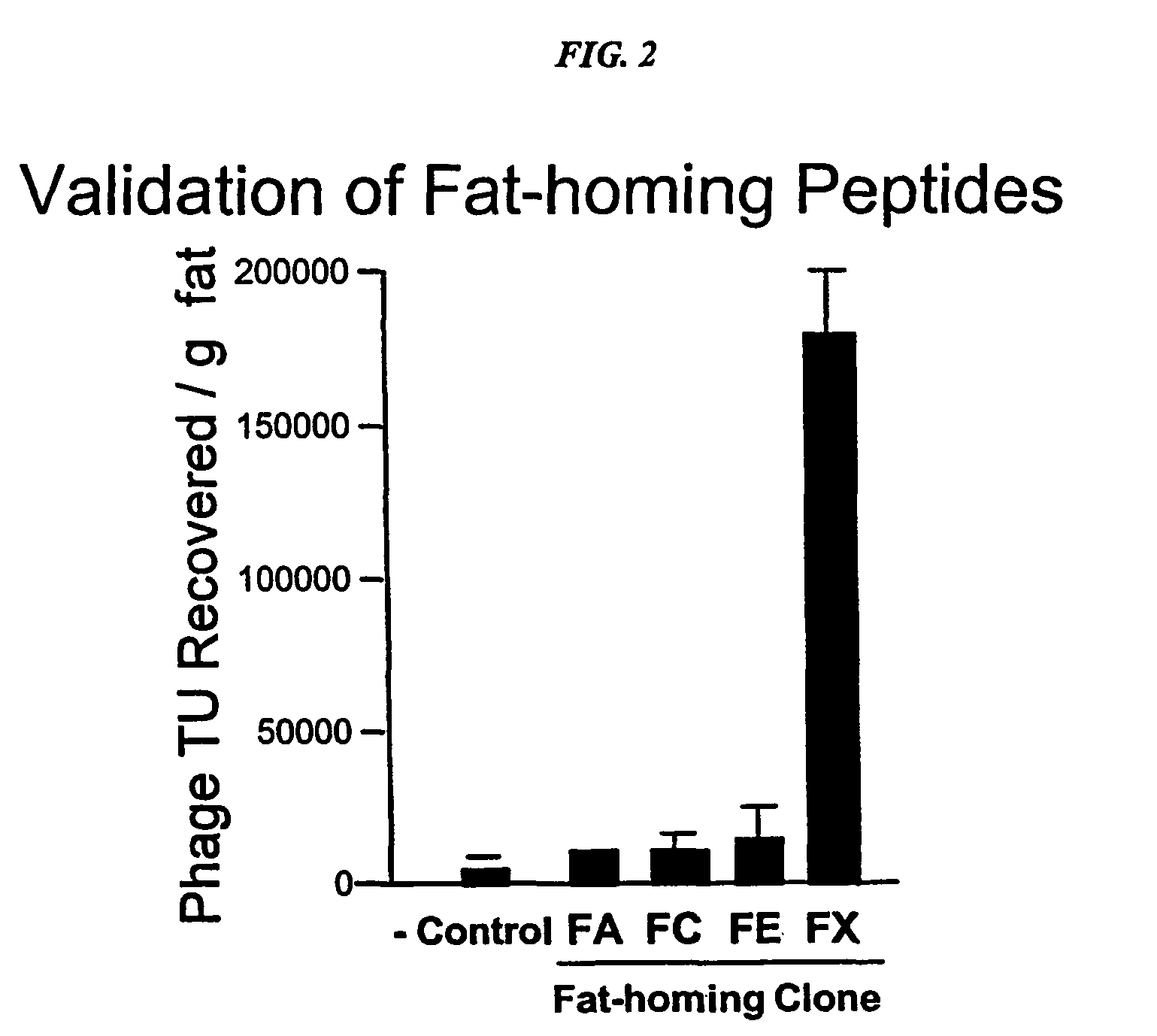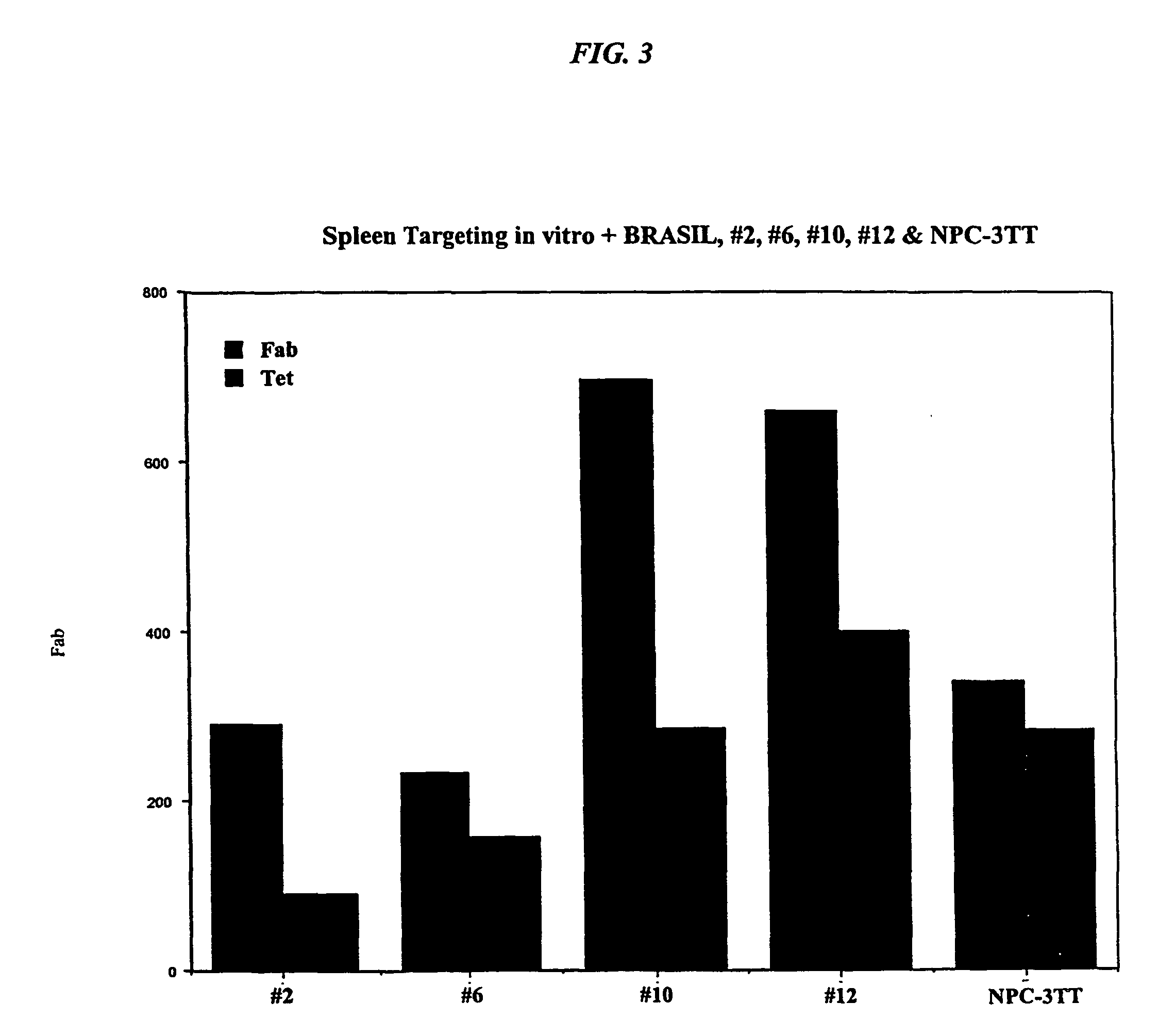Human and mouse targeting peptides identified by phage display
a technology of human and mouse, which is applied in the field of molecular medicine and targeted delivery of therapeutic agents, can solve the problems of slow and laborious process of identification of previously unknown receptors and previously uncharacterized ligands, and limited treatment of many disease states
- Summary
- Abstract
- Description
- Claims
- Application Information
AI Technical Summary
Problems solved by technology
Method used
Image
Examples
example 1
Bone Marrow Targeting Peptides
[0180] A non-limiting example of an organ of specific interest for targeting petides is bone marrow. Bone is the preferred site of metastasis in the large majority of patients with prostate cancer (Fidler, 1999). This striking selectivity has been viewed as an example of site-specific interactions that were essential to cancer progression (Rak, 1995; Zetter, 1998). Despite the clinical relevance, little is known about the mechanisms that control prostate cancer spread to bone. In addition, there were no effective strategies for targeting therapeutic agents for the treatment of metastatic prostate cancer (Brodt et. al, 1996).
[0181] A subset of peptides capable of selective homing to bone marrow through the circulation is likely to simulate the behavior of prostate cancer cells during bone metastasis formation. The vascular markers targeted by using phage display might also be utilized by tumor cells to metastasize. This concept has already been proven to...
example 2
Prostate and Prostate Cancer Targeting Peptides
[0192] Another non-limiting organ of particular interest for targeting is the prostate. Prostate is an unusual organ because it continues to growth throughout adult life. As a result, benign prostate hypertrophy (BPH) affects most elderly men to some degree. Even more serious, the prostate is a frequent site of malignant tumors. One out of eleven men will develop prostate cancer during their lifetime. Because serum markers for prostate cancer were available, many of these malignant tumors were currently detected early in the course of the disease. In the absence of reliable ways of predicting which ones will progress clinically, many were aggressively treated with surgery or radiotherapy, often with devastating side-effects such as incontinence and impotence (Lane and Shah, 1999; Mikolajczyk et al., 2000). There is a clear need for improved methods for detection, prognosis, and treatment of human prostate cancer.
[0193] Many interesting ...
example 3
Identification of Mouse Placenta, Adipose, Ovary and Ureter Targeting Peptides
[0209] Identification of Placenta Homing Peptides
[0210] Peptides homing to the mouse placenta were identified by a post-clearing protocol using a phage display library. A first round of biopanning was performed on pregnant mice. Samples of placenta were removed and phage rescued according to the standard protocols described above, with one modification. In the typical bipanning protocol, thousands of phage may be recovered from a single organ, tissue or cell type. Typically, between 200 and 300 individual colonies were selected from plated phage and these were amplified and pooled to form the phage display library for the second or third rounds of biopanning. In this example, all phage rescued from the first round of biopanning were amplified in bulk on solid medium and then pooled to form the phage display library for the second round of biopanning. That is, there was no restriction of the rescued phage f...
PUM
| Property | Measurement | Unit |
|---|---|---|
| Fraction | aaaaa | aaaaa |
| Fraction | aaaaa | aaaaa |
| Fraction | aaaaa | aaaaa |
Abstract
Description
Claims
Application Information
 Login to View More
Login to View More - R&D
- Intellectual Property
- Life Sciences
- Materials
- Tech Scout
- Unparalleled Data Quality
- Higher Quality Content
- 60% Fewer Hallucinations
Browse by: Latest US Patents, China's latest patents, Technical Efficacy Thesaurus, Application Domain, Technology Topic, Popular Technical Reports.
© 2025 PatSnap. All rights reserved.Legal|Privacy policy|Modern Slavery Act Transparency Statement|Sitemap|About US| Contact US: help@patsnap.com



